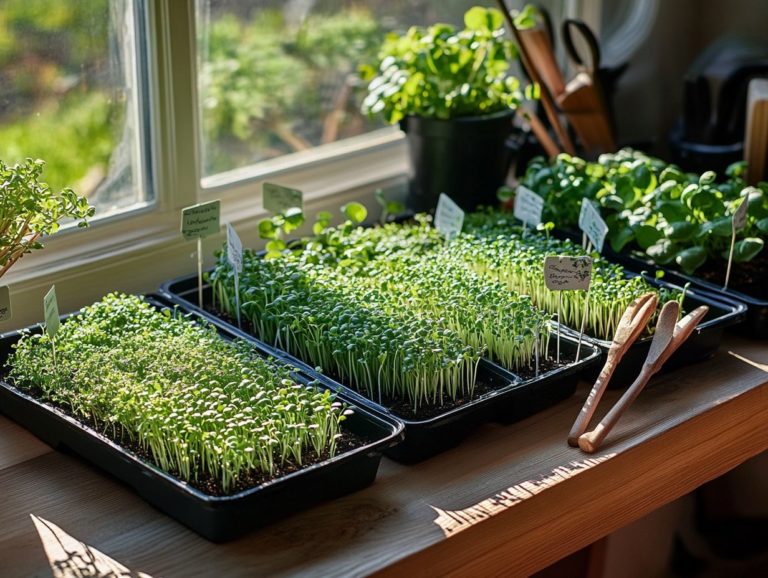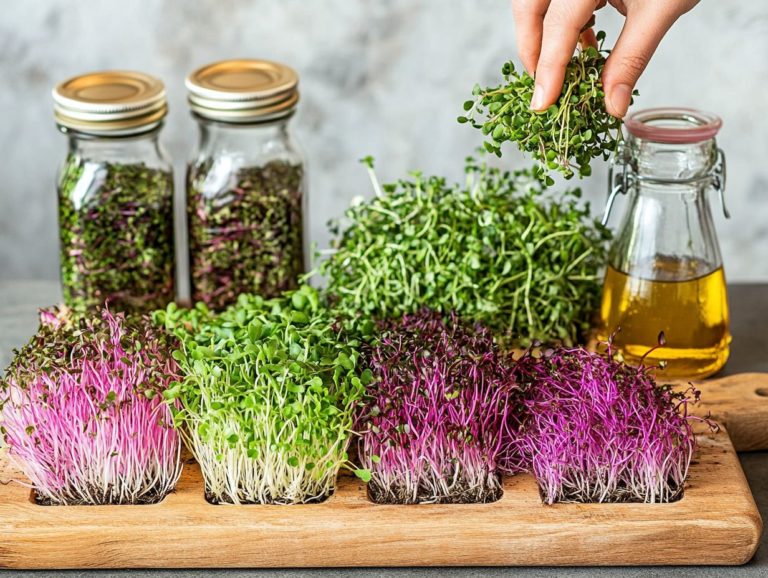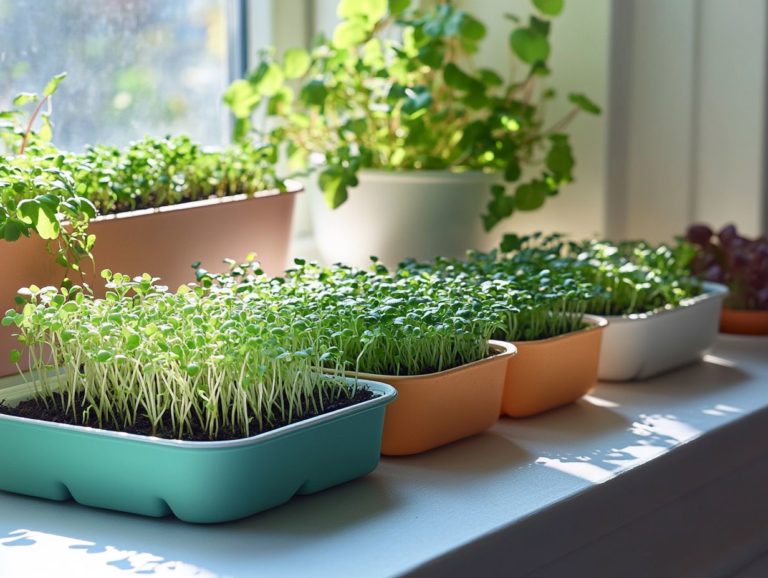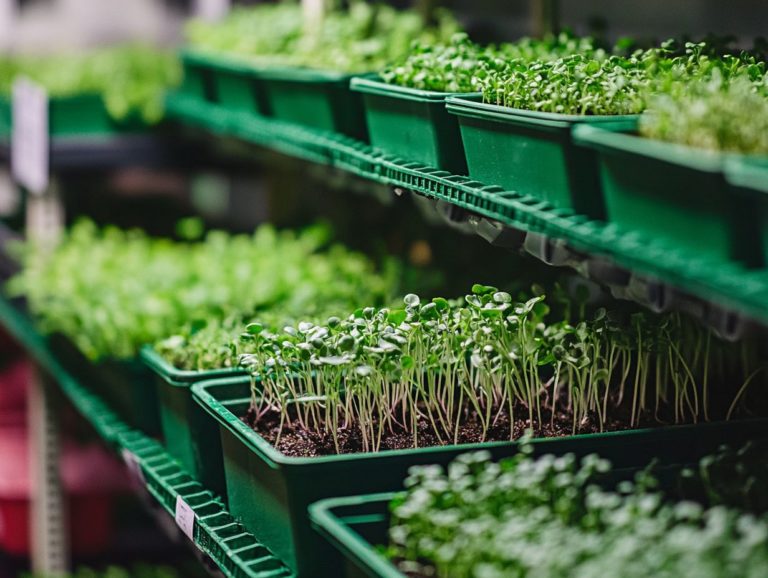Common Pests and Solutions for Microgreens
Microgreens are tiny, nutrient-packed plants that have captured attention in the culinary world. However, they come with their fair share of challenges.
One of the most significant threats to these delicate greens is pests, which can swiftly devastate a flourishing crop. This article delves into the common pests that target microgreens, guiding you on how to identify and prevent them. You will also find effective pest control solutions that are both natural and chemical-free.
Additionally, you ll discover best practices for maintaining a healthy growing environment. This ensures that your microgreens thrive without unwanted visitors.
Explore these insights to protect your greens and enjoy a bountiful harvest!
Contents
- Key Takeaways:
- Common Pests that Affect Microgreens
- Solutions for Pest Control
- Best Practices for Growing Pest-Free Microgreens
- Dealing with Pests in Different Stages of Growth
- Frequently Asked Questions
- What are some common pests that affect microgreens?
- How can I identify a pest infestation on my microgreens?
- What are some natural solutions for controlling pests on microgreens?
- What can I do to prevent pest infestations on my microgreens?
- Are there any chemical solutions for controlling pests on microgreens?
- Can I use organic methods for pest control on my microgreens?
Key Takeaways:

- Identify and prevent potential pests from affecting your microgreens by maintaining a healthy growing environment and practicing good sanitation.
- Utilize natural and chemical-free methods to control common pests such as neem oil, diatomaceous earth, and companion planting.
- Be proactive in preventing and treating pests at different stages of growth to ensure healthy and thriving microgreens. This includes regular monitoring, crop rotation, and proper disposal of infected plants.
What are Microgreens?
Microgreens are young, edible plants that you can harvest just after the plant’s first real leaves make their appearance. They offer a delightful burst of flavor and a treasure trove of nutrients.
These petite greens, which can include a variety of vegetables such as radishes, basil, and arugula, elevate the taste of your dishes while significantly boosting your health thanks to their rich vitamin and mineral content.
Grown in small quantities, they re perfect for your microgreens garden, making them an ideal choice even if you re an urban dweller with limited gardening space.
The charm of microgreens extends beyond their vibrant colors and diverse flavors; they pack an impressive concentration of antioxidants and essential vitamins A, C, E, and K, along with vital minerals.
With just a small soil tray, some seeds, and a sunny windowsill, you can easily cultivate these nutrient-dense plants right in your kitchen.
Culinary enthusiasts often weave them into salads, sandwiches, and garnishes, showcasing their remarkable versatility. You don t need an elaborate setup; a simple arrangement with adequate light and moisture will ensure a fresh supply of these culinary gems all year round.
Common Pests that Affect Microgreens
Common pests that affect microgreens can greatly impede their growth and diminish overall yields, making it crucial for you to understand these nuisances for successful cultivation.
Pests like aphids, which feed on plant sap, can compromise the health of your microgreens and leave them vulnerable to additional diseases.
Implementing effective pest control strategies is essential to mitigate the risk posed by these pests, allowing your microgreens to thrive without interruption. For more insights, check out our guide on troubleshooting common microgreen growth issues. Ensuring a healthy crop is not just beneficial; it’s vital for your flourishing garden.
Identifying and Preventing Pests
Identifying and preventing pests in microgreens is essential for you to maintain healthy crops and ensure optimal growth conditions. Recognizing signs of infestation from common pests like aphids and fungal pathogens can save you time and resources in the long run.
By implementing effective risk prevention measures, such as conducting regular checks and maintaining a clean growing environment, you greatly enhance your chances of cultivating vibrant microgreens and keeping them safe from common microgreen pests.
In addition to visual inspections, employing sticky traps can help you monitor pest populations and catch those early invaders. Look out for symptoms of pest activity, such as wilting leaves, discolored patches, or a sticky residue on your plants these often signal the presence of unwelcome guests.
To further bolster your defenses, consider techniques like crop rotation and introducing good bugs that help control pests, which can significantly reduce pest pressure. Make sure your plants get the right amount of water and light so they flourish!
By actively engaging in these practices, you can create a thriving ecosystem that minimizes pest problems and maximizes your harvest.
Start your pest prevention journey today for a thriving microgreens garden!
Solutions for Pest Control
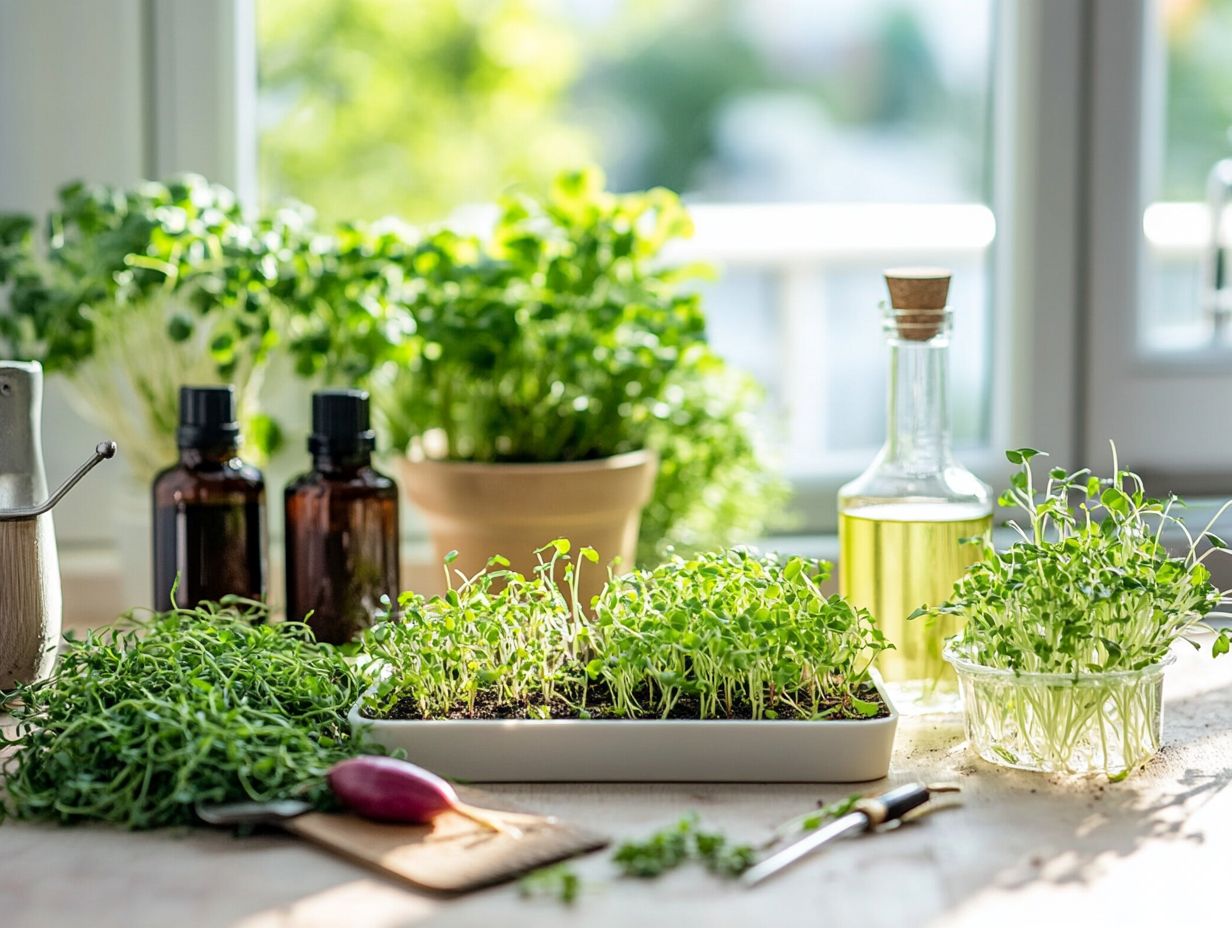
Solutions for pest control in microgreens encompass various strategies that effectively target pests while reducing the risk of diseases that could compromise your crops. It s essential to employ both bacterial and fungal solutions. This approach ensures your microgreens remain dry and healthy while promoting excellent air circulation.
By tackling potential bacterial infections and fungal diseases head-on, you can safeguard your harvest from pests and uphold the quality of your microgreens. For more information on this, check out our guide on how to prevent spoilage in microgreens.
Natural and Chemical-Free Methods
Natural and chemical-free methods for controlling pests in microgreens are gaining traction among growers who prioritize sustainable practices. Techniques such as neem oil and grapefruit seed extract effectively manage pest populations and align with good agricultural practices.
These eco-friendly approaches not only safeguard your microgreens but also foster a healthier growing environment. Incorporating these substances minimizes negative environmental impacts and promotes biodiversity in your growing areas.
Neem oil, extracted from the seeds of the neem tree, serves as a potent insect repellent and disrupts the life cycle of harmful pests without harming beneficial insects. Similarly, grapefruit seed extract boasts antifungal properties, helping to combat disease pathogens and enhance overall plant health.
Utilizing these natural solutions supports a holistic approach to cultivation. This allows you to produce nutritious microgreens while ensuring your practices remain sustainable and in harmony with organic standards. For effective pest management, consider the top pest control supplies for microgreens.
Best Practices for Growing Pest-Free Microgreens
To cultivate pest-free microgreens, focus on establishing a best growing environment that fosters health while minimizing the risk of pest infestations. Key elements such as proper air circulation and adequate light exposure are vital for stimulating growth and deterring pests.
By embracing these best practices, you can ensure robust development and exceptional quality in your microgreens.
Tips for Maintaining a Healthy Growing Environment
A healthy growing environment is the key to thriving microgreens! It directly influences their health and resilience against pests and diseases. Keep your microgreens dry to prevent fungal diseases and ensure consistent air circulation and optimal light exposure.
For optimal moisture control, consider using well-draining soil. Ensure your trays don t sit in standing water, as this can lead to root rot.
Implementing fans or strategically placing air vents can greatly improve air circulation, helping distribute temperature and humidity evenly. Utilizing LED grow lights provides the perfect spectrum for photosynthesis, ensuring strong growth without the risk of overheating.
By closely monitoring these factors, you create an environment where pests are less likely to thrive, leading to a more productive and sustainable microgreens operation! For those facing challenges, learning how to troubleshoot microgreen growth problems can be invaluable.
Dealing with Pests in Different Stages of Growth
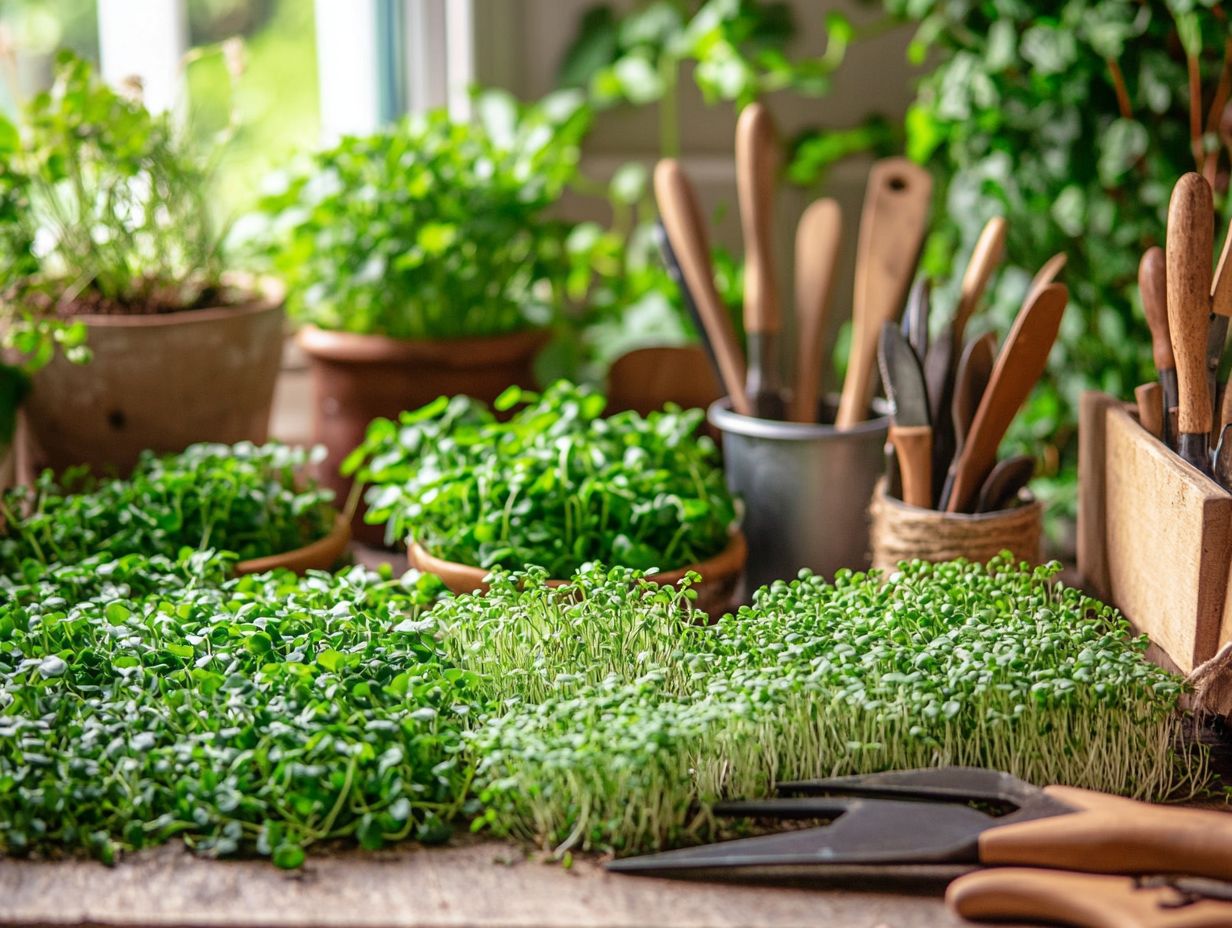
Managing pests at different growth stages requires a tailored strategy that targets the unique vulnerabilities of microgreens throughout their development. It’s crucial to recognize how pests impact young seedlings differently than mature plants, as this understanding is key to effective risk prevention and the successful cultivation of microgreens.
By tailoring pest control measures to each specific growth stage, you can safeguard your crops with greater efficiency and enhance their overall health.
Act quickly to protect your crops from pests at every stage of growth!
Preventative Measures and Treatment Options
Preventative measures and treatment options are crucial for safeguarding your microgreens from pests and diseases throughout their cultivation journey. By employing strategies that prevent fungal diseases, you can significantly enhance the overall health of your microgreens.
Using pest control methods allows you to adopt a proactive approach, ensuring your crop thrives. Implementing cultural practices, such as crop rotation and maintaining proper sanitation, can effectively reduce the likelihood of pest infestations.
Using biological controls, like introducing beneficial insects that act as natural predators, can strengthen the defenses of your delicate plants. For more detailed strategies, check out how to control pests in microgreen farming. Regularly check your plants for early signs of pests and diseases to intervene swiftly, minimizing spread and potential damage.
Incorporating organic fungicides into your regimen can also help combat fungal issues, ensuring that your microgreens remain safe for consumption. Ultimately, combining these strategies creates a comprehensive shield against the myriad challenges you may face while cultivating microgreens.
Frequently Asked Questions
Here are some frequently asked questions about pest management for microgreens:
What are some common pests that affect microgreens?
Some common pests include aphids, thrips, spider mites, and fungus gnats. Additionally, microgreen pest control methods can be effective in managing these issues. It’s also important to be aware of viral diseases that may affect your plants.
How can I identify a pest infestation on my microgreens?
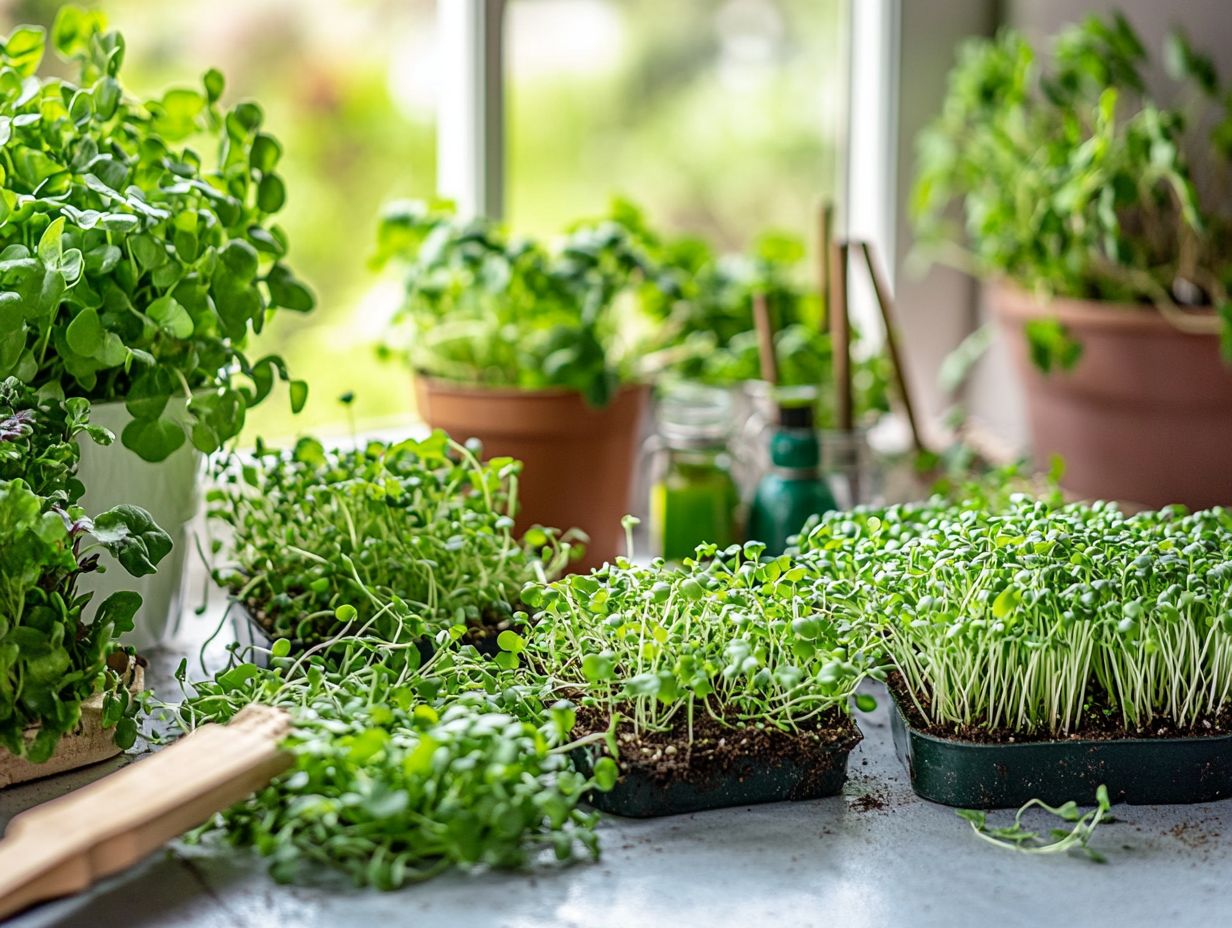
Look for signs such as small holes in the leaves, discolored or wilted leaves, and the presence of small insects on the plants.
What are some natural solutions for controlling pests on microgreens?
One natural solution is to use Neem oil, a natural insecticide, by diluting it in water and spraying it on the affected plants. Other options include introducing beneficial insects such as ladybugs or lacewings to feed on the pests. Implementing seed treatment can also support the health of your microgreens.
What can I do to prevent pest infestations on my microgreens?
Practicing good hygiene by regularly cleaning and sanitizing your growing area can help prevent pest infestations and damping-off. Also, avoid over-watering your microgreens, as this can create a favorable environment for pests to thrive and lead to issues like Botrytis and Pythium.
Are there any chemical solutions for controlling pests on microgreens?
Yes, there are chemical pesticides available for controlling pests on microgreens. However, it is important to use them carefully and according to the instructions to avoid harming the plants or consuming harmful chemicals.
Can I use organic methods for pest control on my microgreens?
Yes, there are several organic methods for pest control, such as introducing beneficial insects, using organic plant-based insecticides, and practicing crop rotation. These methods are safe for consumption and do not harm the environment, benefiting the overall health of microgreens.
Stay proactive to keep your microgreens thriving!


